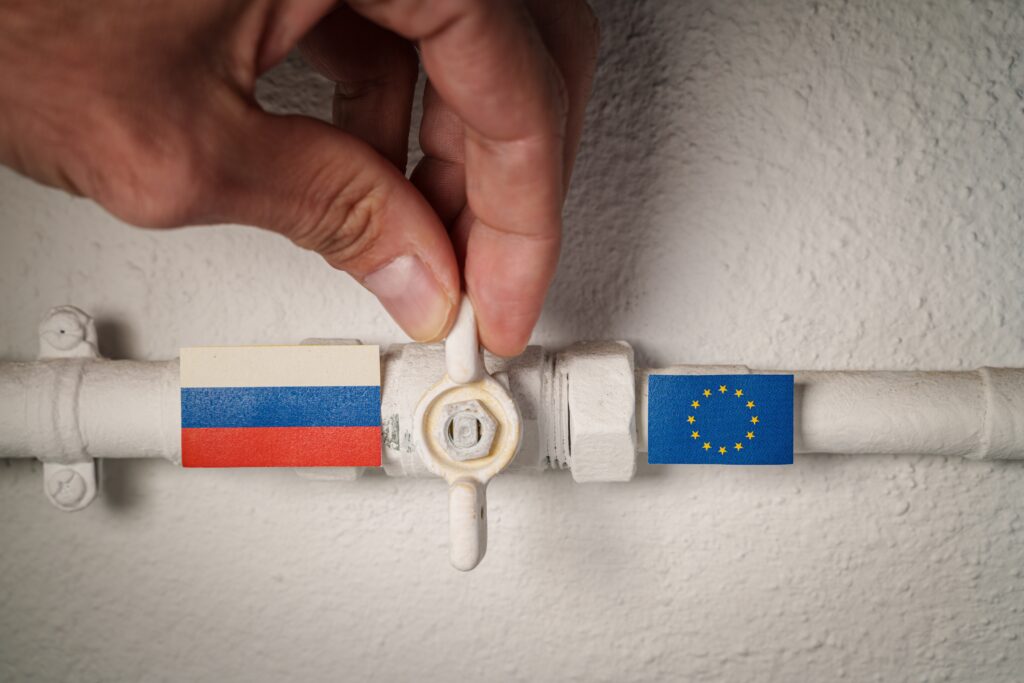Three years after Russia’s full-scale invasion of Ukraine, Paul Hockenos compares the efforts of the EU and the US in view of weaning from Russian fossil fuels. On the ground, Ukraine’s transition to distributed renewables already rhymes with resilience against the aggressor.

Credits: Ivan Marc, All rights reserved.
‘Now climate protection and geosecurity are irrevocably linked. They are one thing – and this changes everything,’ German think-tanker R. Andreas Kraemer of Ecologic Institute explained at the onset of Russia’s full invasion of Ukraine in February 2022. His rationale: Russia’s export fossil fuels to Western Europe fills the coffers of the Russian autocrat Putin with means for his war efforts – and therefore must end. Also, Europe’s reliance on Russia for such a large volume of its energy is obviously irrational as it endows Moscow with inordinate power over Europe, a lever that Putin had already made use of on several occasions. The logical upshot: Europe has to drop Russian fossil fuels as quickly as possible – to drain Russia’s war chest and make itself independent of Russian energy leverage.
In the ensuing months, the EU announced a boycott of Russian oil and coal – and Putin responded with a suspension much of Russian gas exports to much of Western Europe. Kraemer advocated a turbocharged rollout of renewable energy systems that would make Europe more energy autonomous (at first at least from Russia) and further the cause of climate protection.
Alas, it didn’t pan out exactly as Kraemer had envisioned. Although much of Europe – and Germany in particular – has weaned itself off much of Russia’s fossil fuels, even today Western Europe imports liquefied natural gas (LNG) from Russia. According to the Financial Times, EU countries’ imports from Russia – led by France, Spain, Netherlands, and Belgium – reached an all-time high in 2024, more even than in 2021 and 2022 – a disturbing 25 percent rise over 2023.
Also, Russia has managed to redirect its market reach to its east and keep revenues flowing, though not at the scale of 2022. And although countries like Germany are predominantly off the Russian tap, its needs are served by gas flows from the US, Norway, Belgium, the Netherlands, and elsewhere. The EU is building out its renewable energy resources at a record pace, but not enough to fill the gap left by Russia.
‘Although Russian fossil fuel exports to the West have decreased,’ concludes the Center for the Study of Democracy (CSD), a Bulgaria-based think tank, ‘glaring loopholes in the sanctions’ regime persist.’
Svitlana Romanko, director and founder of the Ukrainian NGO Razom We Stand spelled it out bluntly: ‘Let us be clear: every euro spent on Russian LNG fuels more destruction, suffering, and war. The solutions are here – renewable energy and energy efficiency. Now, we only need the political will to speed up the changes already in progress.’
Finally getting tough
Before leaving office, the Biden administration was striving to put the most stringent energy sanctions yet against Russia in place – measures that the Trump administration would find tough to reverse. On 13 January 2025, the US imposed sanctions on Moscow’s ‘shadow fleet’, namely aging tankers that carry Russian crude oil and LNG but fly under foreign flags. The EU’s 15th sanctions package, finalized on 16 December 2024, bars 79 suspected non-EU ships from entering EU ports (the UK recently imposed similar embargos on ships). Moreover, Denmark, Sweden, Poland, Finland, Estonia, and the UK will now inspect the insurance certificates of oil tankers along the route used by the shadow fleet through the English Channel, the Danish Straits, and the Gulf of Finland, according to OilPrice.com. Moreover, G7 countries are examining new measures: from a full ban on handling Russian crude to reducing the price cap on Russian oil (USD60 a barrel) to about USD40.
Moreover, on 1 January 2025, Kyiv confirmed that no more Russian energy will travel through Ukraine. Despite Ukraine’s warnings, Austrian, Italian, Slovakian, and Hungarian manufacturers protested vigorously – and futilely – to the EU Commission in December 2024, claiming that Ukraine’s decision not to renew the contract threatened security of supply.
Renewables for Ukraine
The other side of the coin – for Europe and Ukraine both – is expanding clean energy generation and its infrastructure. Compared to huge thermal plants and energy networks, it is harder for Russian forces to target distributed solar arrays and wind turbines. Moreover, they are easier to repair should they be hit.
Ukrainian officials and NGOs bend over backward to illustrate that boosting Ukraine’s renewables supply is a win-win proposition, not just freebies for Ukraine: ‘Increased collaboration would also boost demand for US-made clean energy technologies, such as solar panels, wind turbines, and energy storage systems,’ argued the NGO Razom We Stand to US policymakers this year in the US, an argument it makes in Europe, too. ‘This, in turn, would revitalize domestic-quality job creation in the energy sector as fossil fuel industries like coal disappear. This aligns with post-pandemic economic recovery efforts by creating high-skilled jobs and bolstering domestic supply chains.’
Ukraine has begun rolling out solar fields – but slowly. Outfitting the entire country with renewables – and therewith replacing all of its thermal and nuclear power – is a proposition that will take decades. But that is not an argument against its wisdom or feasibility. Ukraine, at least, well understands the link between its security and climate protection. And it is sinking in slowly in the rest of Europe, too.
The views and opinions in this article do not necessarily reflect those of the Heinrich-Böll-Stiftung European Union.